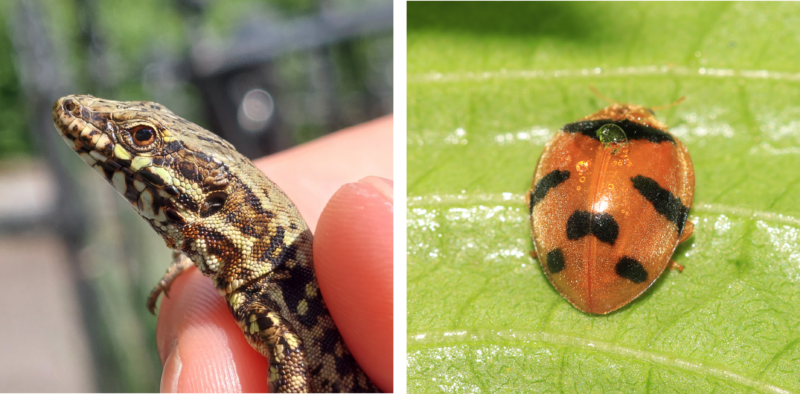The rapid environmental changes accelerated by human activities have facilitated the introduction of invasive species worldwide. In this process, many of these species have become extinct, while others have managed to survive but are not considered invasive. However, there are a few that have thrived, gained reproductive success, and spread extensively, thereby altering the local eco-evolutionary dynamics.
For instance, a case in Switzerland demonstrates the rapid and sudden expansion of the range of a native species of wall lizards, Podarcis muralis, within just two decades. Interestingly, the spreading population of lizards does not exhibit the phenotypic characteristics of the native lizards. These phenotypic differences suggest the possibility that the expanding lizards may not representing the native lizards, but rather introduced subspecies or possibly the result of genetic hybridisation between the native lizards and other subspecies whose ranges overlap, such as the Italian lineage and the southern Alps lineages. While hybridisation often carries a negative connotation due to its homogenising effect on gene pools, recent shifts in understanding have revealed that in certain cases, hybridisation can enrich genetic variation, potentially facilitating rapid routes to adaptation and speciation.

Moreover, invasive introduced species also have the potential to create new ecological niches for native organisms. During the era of European exploration to and colonisation of the East, Europeans brought numerous seeds and introduced high-value economically and aesthetically significant species beyond their native ranges. Many neotropical plants now thrive in Southeast Asia, primarily due to similar microclimatic conditions. These species present new and challenging obstacles to overcome, but they also have the potential to open up new ecological opportunities for local herbivores.
One example is a phytophagous ladybird beetle species in Southeast Asia that has repeatedly colonised an introduced invasive plant within a relatively short period. Similar colonisation patterns have been observed in other ladybird beetle species within the same tribe. Interestingly, in one case, adaptation to the new habitat has the potential to act as a critical driving force in population divergence or speciation due to host plants specialisation, while in some cases, it leads to generalisation.
In my PhD, I am interested in characterising the evolutionary agents that drive genetic changes enabling a species to spread rapidly (Podarcis muralis lizard project) and the genomic features that facilitate repeated behavioural radiation in Southeast Asia (Henosepilachna diekei phytophagous ladybird beetle project).

With long-read technologies becoming more accessible and the recent surge in the number of publicly available chromosomally resolved genomes, interest in the role of structural variations and chromosomal rearrangements in speciation and adaptive radiation has resurfaced. I would like to use this opportunity to particularly focus on these aspects in addressing my questions. For instance, closely related Ithomiini butterfly species differ strongly in the number of chromosomes, ranging from 5 to 120. By taking advantage of multiple hybrid zones in Peru, where over 30 species of Ithomiini butterflies form hybrid zones between Amazonian and Andean subspecies with different ranges of RI levels, we could test whether subspecies with complex chromosomal rearrangements exhibit lower gene flow compared to those with none or fewer simple fusions and fissions.
Lastly, I will also test how rates of rearrangements are associated with speciation rates in macroevolutionary studies across several orders of insects to further assess the importance of such barriers across different taxa.

Prior to my PhD, I have also been involved in several projects (MEME programme) related to the genetic basis of speciation in popular model systems. With Matteo Rossi and Richard Merrill, we have functionally validated the genetic basis of visual mate preference in Heliconius butterflies. Using genome editing, we have knocked out one of the five candidate genes recently found to be strongly associated with preference behaviours across the broader Heliconius clade. In another opportunity, with Marjolaine Rousselle and Carole Smadja, we are investigating the presence, link, and causes of fast-X and large-X effects, exploring the role of sex chromosome evolution in the development of reproductive isolation across the continuum of divergence using various pea aphid, Acyrthosiphon pisum, host-specialised biotypes.
My timeline
Starting as PhD student at the Wellcome Sanger Institute, University of Cambridge (Meier and Jaron Group)
Master of Science in Evolutionary Biology, Ludwig-Maximilians-Universität München + Université de Montpellier
Visiting Graduate Student at Meier's Group, Wellcome Sanger Institute (S4 MEME)
Research Intern at Smadja's Group, Centre de Biologie pour la Gestion des Populations, Université de Montpellier (S3 MEME)
Assistant Curator at Schmidt's Group, SNSB-Zoologische Staatssammlung München
Student Researcher at Merrill's Group, Ludwig-Maximilians-Universität München (S2 MEME)
Research Intern at von Rintelen's Group, Museum für Naturkunde Berlin
Starting as MSc student of the Erasmus Mundus Master Programme in Evolutionary Biology (MEME), Rijksuniversiteit Groningen (S1 MEME)
Bachelor of Science in Biological Sciences, Bogor Agricultural University
Visiting Undergraduate Student of Erasmus+ KA107 Programme, Sveuciliste u Zagrebu
Student Researcher at Kahono's Group, Indonesian Institute of Sciences
Starting as BSc student of Biological Sciences, Bogor Agricultural University
